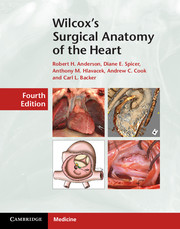Book contents
- Frontmatter
- Contents
- Preface
- Acknowledgements
- Surgical approaches to the heart
- Anatomy of the cardiac chambers
- Surgical anatomy of the valves of the heart
- Surgical anatomy of the coronary circulation
- Surgical anatomy of the conduction system
- Analytical description of congenitally malformed hearts
- Lesions with normal segmental connections
- Lesions in hearts with abnormal segmental connections
- Abnormalities of the great vessels
- Positional anomalies of the heart
- Index
- References
Abnormalities of the great vessels
Published online by Cambridge University Press: 05 September 2013
- Frontmatter
- Contents
- Preface
- Acknowledgements
- Surgical approaches to the heart
- Anatomy of the cardiac chambers
- Surgical anatomy of the valves of the heart
- Surgical anatomy of the coronary circulation
- Surgical anatomy of the conduction system
- Analytical description of congenitally malformed hearts
- Lesions with normal segmental connections
- Lesions in hearts with abnormal segmental connections
- Abnormalities of the great vessels
- Positional anomalies of the heart
- Index
- References
Summary
ANOMALOUS SYSTEMIC VENOUS DRAINAGE
Abnormal systemic venous connections are usually of little surgical significance, as their clinical consequences are limited. The anomalies are apt to be encountered as the surgeon pursues a more complex associated intracardiac anomaly. They are of most significance in the setting of isomeric atrial appendages, which we discuss in Chapter 10, showing how so-called visceral heterotaxy is best considered in terms of right versus left isomerism. In this chapter, we consider the features of the anomalous systemic venous connections in their own right. They may be grouped into the categories of absence or abnormal drainage of the right superior caval vein, anomalies of the inferior caval vein, persistence or abnormal drainage of the left superior caval vein, and abnormal hepatic venous connections. Abnormalities of the coronary sinus usually fall into one of these groups, although unroofing, which produces an interatrial communication through the right atrial orifice of the sinus, has been discussed in Chapter 7.
Abnormalities of the right superior caval vein
These are extremely rare. The vein may be diminished in size. Alternatively, it may be completely absent when the venous return from the head, neck, and arms passes through a persistent left superior caval vein to the right atrium by way of the coronary sinus (Figure 9.1) or, rarely, directly into the left atrium. Only this last situation requires surgical intervention. The other conditions, if encountered during an open-heart operation, would require some adjustment from the usual technique used for cannulation. Although there is no definite evidence to this effect, we would not expect these abnormalities to affect the location of the sinus node.
- Type
- Chapter
- Information
- Wilcox's Surgical Anatomy of the Heart , pp. 321 - 362Publisher: Cambridge University PressPrint publication year: 2013

